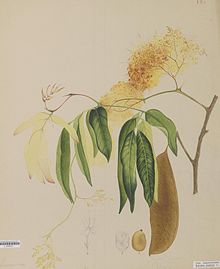Saraca indica: Difference between revisions
No edit summary |
|||
| (13 intermediate revisions by 10 users not shown) | |||
| Line 1: | Line 1: | ||
{{short description|Species of plant}} |
|||
{{Speciesbox |
|||
{{Italic title}} |
|||
{{Taxobox |
|||
| name = Ashoka tree |
| name = Ashoka tree |
||
| ⚫ | |||
| image = Naturalis Biodiversity Center - L.0939531 - Aken, J. van - Saraca indica Linnaeus - Artwork.jpeg |
| image = Naturalis Biodiversity Center - L.0939531 - Aken, J. van - Saraca indica Linnaeus - Artwork.jpeg |
||
| image_caption = |
| image_caption = |
||
| |
| status = LC |
||
| ⚫ | |||
| unranked_divisio = [[Angiosperms]] |
|||
| status_ref = |
|||
| unranked_classis = [[Eudicots]] |
|||
| ⚫ | |||
| unranked_ordo = [[Rosids]] |
|||
| |
| species = indica |
||
| ⚫ | | authority = [[Carl Linnaeus|L.]]<ref name=TPL>{{cite web |url=http://www.theplantlist.org/tpl1.1/record/ild-1691 |title=Saraca indica L. — The Plant List |website=The Plant List |date=6 January 2015 |access-date=6 January 2016 |archive-date=15 December 2019 |archive-url=https://web.archive.org/web/20191215081953/http://www.theplantlist.org/tpl1.1/record/ild-1691 |url-status=live }}</ref> |
||
| familia = [[Fabaceae]] |
|||
| ⚫ | |||
| ⚫ | |||
| species = '''''S. indica''''' |
|||
| binomial = ''Saraca indica'' |
|||
| ⚫ | |||
| ⚫ | |||
{{Plainlist | style = margin-left: 1em; text-indent: -1em; | |
{{Plainlist | style = margin-left: 1em; text-indent: -1em; | |
||
*''Jonesia asoca'' <small>misapplied</small> |
*''Jonesia asoca'' <small>misapplied</small> |
||
| Line 31: | Line 25: | ||
}} |
}} |
||
'''''Saraca indica''''', commonly known as '''asoka |
'''''Saraca indica''''', commonly known as the '''asoka tree''', '''ashok''' or simply '''asoca''',<ref name=GBIF>{{cite web |url=https://www.gbif.org/species/5359538 |title=Saraca indica L. — Checklist View |website=GBIF |date=6 January 2015 |access-date=22 March 2018 |archive-date=5 June 2023 |archive-url=https://web.archive.org/web/20230605113529/https://www.gbif.org/species/5359538 |url-status=live }}</ref> is a plant belonging to the subfamily [[Detarioideae]] of the family [[Fabaceae]]. The original plant specimen from which [[Carl Linnaeus]] described the species came from [[Java]], but the name ''S. indica'' has been generally incorrectly applied to [[Saraca asoca|''S. asoca'']] since 1869.<ref>{{citation |author=Zuijderhoudt, G.F.P. |year=1968 |title=A revision of the genus ''Saraca'' L. — (Legum. Caes.) |journal=Blumea |volume=15 |pages=413–425 |url=http://www.repository.naturalis.nl/document/565670 |access-date=2016-01-06 |archive-date=2016-03-04 |archive-url=https://web.archive.org/web/20160304060416/http://www.repository.naturalis.nl/document/565670 |url-status=live }}</ref> It can be distinguished from ''S. asoca'' by its non-clasping bracteoles, a lower number of ovules, slightly smaller pods, and a more eastern geographic distribution.<ref name="Current Science">[http://www.currentscience.ac.in/Volumes/107/01/0026.pdf ‘Asoka’ – an important medicinal plant, its market scenario and conservation measures in India] {{Webarchive|url=https://web.archive.org/web/20160304081534/http://www.currentscience.ac.in/Volumes/107/01/0026.pdf |date=2016-03-04 }}, table 1.</ref> |
||
| ⚫ | |||
| ⚫ | |||
| ⚫ | The seeds are eaten by monkeys and squirrels, and Thai people eat the flowers and leaves of one variety of the species.<ref>{{cite book|last1=Hargreaves|first1=Dorothy|last2=Hargreaves|first2=Bob|title=Tropical Trees of the Pacific|year=1970|publisher=Hargreaves|location=Kailua, Hawaii|page=5}}</ref> |
||
<gallery> |
|||
| ⚫ | ''Saraca'' is sometimes confused with the false ashoka, ''[[Monoon longifolium]]'', which is a lofty evergreen tree native to India. It exhibits symmetrical pyramidal growth with willowy weeping pendulous branches and long narrow lanceolate leaves with undulate margins. The false ashoka tree is known to grow over 30 ft in height. |
||
</gallery> |
|||
== |
==References== |
||
{{Reflist}} |
|||
<references /> |
|||
*{{Commons category-inline}} |
|||
{{Commonscat}} |
|||
{{Taxonbar|from=Q17484568}} |
{{Taxonbar|from=Q17484568}} |
||
[[Category:Saraca]] |
[[Category:Saraca|indica]] |
||
Latest revision as of 15:47, 7 July 2024
| Ashoka tree | |
|---|---|

| |
| Scientific classification | |
| Kingdom: | Plantae |
| Clade: | Tracheophytes |
| Clade: | Angiosperms |
| Clade: | Eudicots |
| Clade: | Rosids |
| Order: | Fabales |
| Family: | Fabaceae |
| Genus: | Saraca |
| Species: | S. indica
|
| Binomial name | |
| Saraca indica | |
| Synonyms[1] | |
| |
Saraca indica, commonly known as the asoka tree, ashok or simply asoca,[2] is a plant belonging to the subfamily Detarioideae of the family Fabaceae. The original plant specimen from which Carl Linnaeus described the species came from Java, but the name S. indica has been generally incorrectly applied to S. asoca since 1869.[3] It can be distinguished from S. asoca by its non-clasping bracteoles, a lower number of ovules, slightly smaller pods, and a more eastern geographic distribution.[4]
The seeds are eaten by monkeys and squirrels, and Thai people eat the flowers and leaves of one variety of the species.[5]
Saraca is sometimes confused with the false ashoka, Monoon longifolium, which is a lofty evergreen tree native to India. It exhibits symmetrical pyramidal growth with willowy weeping pendulous branches and long narrow lanceolate leaves with undulate margins. The false ashoka tree is known to grow over 30 ft in height.
References
[edit]- ^ a b "Saraca indica L. — The Plant List". The Plant List. 6 January 2015. Archived from the original on 15 December 2019. Retrieved 6 January 2016.
- ^ "Saraca indica L. — Checklist View". GBIF. 6 January 2015. Archived from the original on 5 June 2023. Retrieved 22 March 2018.
- ^ Zuijderhoudt, G.F.P. (1968), "A revision of the genus Saraca L. — (Legum. Caes.)", Blumea, 15: 413–425, archived from the original on 2016-03-04, retrieved 2016-01-06
- ^ ‘Asoka’ – an important medicinal plant, its market scenario and conservation measures in India Archived 2016-03-04 at the Wayback Machine, table 1.
- ^ Hargreaves, Dorothy; Hargreaves, Bob (1970). Tropical Trees of the Pacific. Kailua, Hawaii: Hargreaves. p. 5.
 Media related to Saraca indica at Wikimedia Commons
Media related to Saraca indica at Wikimedia Commons

